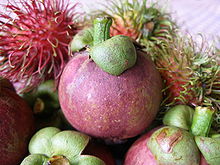Neglected and Underutilized Crop Species
Forgotten, neglected or underutilized crops are often referred to as Neglected and Underutilized Crop Species (NUS) .
Traditionally, NUS are either used as food or feed or are used for fiber or oil production. The medical uses are also of great importance. The great potential of this group to contribute to food and income security has not yet been exploited. In addition, NUS are an important part of intact agricultural ecosystems. A detailed scientific study of NUS was often neglected.
overview

Half of the world's protein and food energy needs are met by just three crops - maize , wheat and rice . 95% of the total food requirement is provided by just 30 plant species. An estimated 7,500 species are edible worldwide. The group of neglected and underutilized plants (NUS) includes all those that could be used to a greater extent for food production or that have even been used increasingly in the past.
In addition to their market potential, many of the NUS also contribute to a stable agricultural ecosystem, as they are well adapted to the various soil properties and climatic conditions.
Assignment
To be assigned to the NUS, three criteria must be met:
- Proven nutritional or energy value
- Proven mounting options
- The plant has been cultivated on a larger scale in the past
- The plant is currently grown in a geographically limited region
- Current cultivation to a lesser extent than comparable plants
properties
NUS have the following general properties:
- They represent an enormous wealth of agrobiodiversity and have great potential to improve the income of the rural population and to contribute to food security. Furthermore, they can counteract the "hidden hunger" that is caused by deficiencies in vitamins and minerals.
- They are of great cultural importance (tradition) in their area of origin.
- NUS are very often local and traditional crops; often their occurrence, biology, cultivation and use are poorly documented.
- They are often adapted to specific agro-ecological niches.
- There is little or no more extensive seed production.
- NUS are known for their local and traditional uses.
- NUS were originally collected in nature or further developed in traditional production systems with little external input.
- NUS are often neglected in the field of research and only play a subordinate role for consultants and politicians, but also for consumers.
- NUS can have a particular nutritional value or have a medicinal value; many can be used multiple times, e.g. B. leaves, wood and roots.
Web links
- The Global Facilitation Unit for Underutilized Species
- International Center for Underutilized Crops (ICUC), website
Databases:
multimedia

